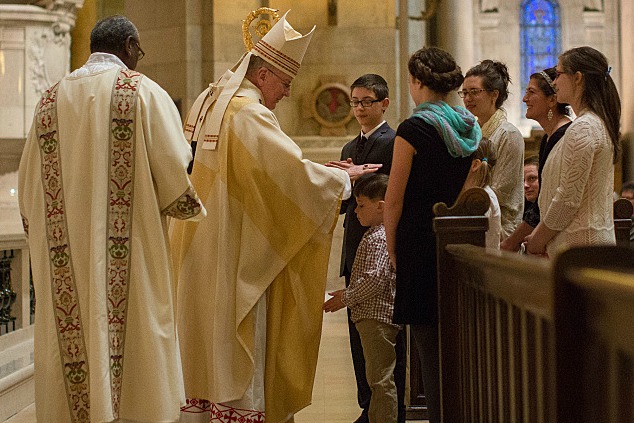If you have spent any time in a parish—or in the Midwest for that matter—you have likely been to a potluck. You know, a meal where various dishes are brought to be shared and enjoyed by all. Sometimes when a group really knows how to throw a good potluck, you may have even been assigned a dish “category” corresponding with the first letter of your last name. Now, those people really know how to throw a good potluck. Potluck meals invite people to show off their culinary talents; similarly, they give others permission to buy that tub of KFC chicken they’ve been craving. Despite the fact that some people (myself included) are lovers of the eclectic potluck meal, there is always the danger of running out of food, or eating a meal entirely comprised of cheese cubes and day-old baked goods because that is all that was left when you finally made your way through the line.
Thank goodness the Eucharist is not your average potluck. At least, not in that previously described understanding of potlucks. There is more than enough to go around and the bread and wine being shared has eternal significance. Fortunately, there is no fighting over the most-coveted items; everyone gets an equal share of the same precious Body and Blood of Christ.
The Presentation of the Offerings at Mass does, however, share some important similarities with the potluck experience, as we—the lay faithful—are invited to contribute to the Eucharistic table.
Following the Prayer of the Faithful, the congregation sits down for what seems to be “half-time” or intermission. Although I am most certainly guilty for occasionally using this part of the Mass as a time to use the restroom or put on chapstick, the Presentation of the Offerings is a hinge moment of the Mass. The Liturgy of the Word transitions into the Liturgy of the Eucharist as the focus shifts from the Book of the Gospels to the Altar of the Lord. In many sanctuaries, candles are moved from the ambo to the altar, signifying the shift in attention: something important is about to take place. Sometimes, those candles even make their way to the back of the church to accompany the gifts of bread and wine (and tithed financial contributions) as they are processed forward and offered by members of the congregation to the priest and other clergy present.
And here lies the beauty of this action: ordinary members of the congregation—perhaps your neighbor from down the street or your former volleyball coach and her family—present the bread and wine (and the parish’s weekly financial donations) for the offering. The gifts presented for the Eucharistic meal are ordinary “staple” items that are brought forward by ordinary people. Bread, a staple across the world for the rich and poor alike, and wine, a drink that symbolizes celebration, communion, and bounty, are brought to the table and offered by a few average people for the sake of the entire community. There are no qualifications to be a gift-bearer—just a willingness to give over what has been given to you for the sake of others.
And perhaps that is the hardest part of it all, and thus an invitation for us all to heed. The Presentation of the Offerings recognizes that what we have been given is not ours to clutch, unwilling to let go. In order to receive in abundance, we must learn to freely give. “The measure with which you measure will be measured out to you” (Mk 4:24).
We read in The General Instruction of the Roman Missal:
It is a praiseworthy practice for the bread and wine to be presented by the faithful. They are then accepted at an appropriate place by the Priest or the Deacon to be carried to the altar. Even though the faithful no longer bring from their own possessions the bread and wine intended for the liturgy as was once the case, nevertheless the rite of carrying up the offerings still keeps its spiritual efficacy and significance.Even money or other gifts for the poor or for the Church, brought by the faithful or collected in the church, are acceptable; given their purpose, they are to be put in a suitable place away from the Eucharistic table. (§73)
As the congregation sings, chants, or sits in silence, we recall that the sacrifice about to take place—of God sending God’s Spirit to sanctify the bread and wine—extends beyond the altar table into our hearts. Just as we present gifts to the altar for consecration, we pray that the offering of our own hearts—our thoughts, hopes, desires, fears, concerns—will be made pure and holy by Christ’s own sacrifice. And the U.S. Bishops, in their description of the Order of the Mass, remind us, “Most wonderful of all, although our offering is in itself imperfect, joined with the offering of Christ it becomes perfect praise and thanksgiving to the Father.”
This point in the Mass always calls me to cry out to God—albeit in my mind—“Prepare the altar of my heart for what You have to give, that my sacrifice—joined with the One Sacrifice—may be made worthy.” And in thinking of what God is asking of me, to give more than just my “extra” time, love, money, and mercy, I cannot help but recall the widow’s mite—the woman who, though lacking much, gave more than the rest because she gave out of her very livelihood (Mk 12:42–44).
If we truly see the Presentation of the Offerings as an opportunity to give the best of what we have—or the worst of ourselves in order for it to be redeemed—it would be hard to skip out on it for a trip to the restroom. After all, I do love a good potluck . . . and this is as good as it gets.
Aimee Shelide Mayer serves as the Coordinator for Recruitment & Admissions for the Echo Program and currently resides in her hometown of Nashville, TN, with her husband, Collen.
